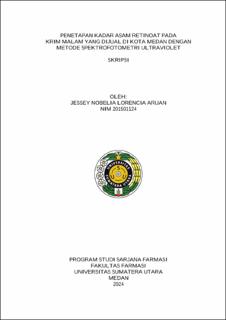Penetapan Kadar Asam Retinoat pada Krim Malam yang Dijual di Kota Medan dengan Metode Spektrofotometri Ultraviolet
Determination of Retinoic Acid Levels in Night Cream That Sold in Medan City Using The Ultraviolet Spectrophotometry Method

Date
2024Author
Aruan, Jessey Nobelia Lorencia
Advisor(s)
Sinaga, Siti Morin
Metadata
Show full item recordAbstract
Background: Retinoic acid was an active ingredient that was often formulated in cosmetics because it had a whitening effect. However, the side effects if used for a long period of time were causing dry skin, irritation and skin cancer. Based on BPOM Regulation No. 17 (2022) retinoic acid was prohibited from being used in cosmetic. Determination of retinoic acid levels could be carried out using the ultraviolet spectrophotometry method because it had the advantages of being easy to use, fast implementation, and good accuracy and precision’s results.
Objective: The aim of this research was to determine whether there was retinoic acid content in night creams sold in Medan City and to determine the levels of retinoic acid contained in night creams sold in Medan City using the ultraviolet spectrophotometry method.
Method: This research was a descriptive study with two stages, the first stage was qualitative analysis carried out using the Thin Layer Chromatography method to identify retinoic acid content and the next stage was determination of retinoic acid levels carried out using the Ultraviolet Spectrophotometry method.
Results: Based on qualitative analysis, the spots on the retinoic acid comparator standard with Rf values was 0.5; samples A, B, C, D and E each 0.5; 0.25; 0.23; 0.5 and 0.26. From these results, samples A and D were positive for retinoic acid. The maximum wavelength was 349 nm, regression equation for determining levels y = 0.02925x-0.00175, limit of detection 0.58708 μg/mL, limit of quantification 1.77903 μg/mL, accuracy (99.92-101.99)%, precision 0.78%, retinoic acid levels in sample A was (0.037±0.002)% and in sample D was (0.033±0.002)%.
Conclusion: samples A and D were positive for retinoic acid and The levels of retinoic acid in samples A and D were obtained in certain amounts.
Collections
- Undergraduate Theses [1719]
